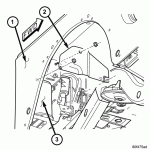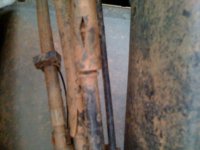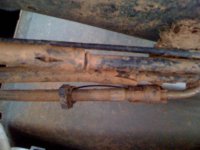You are using an out of date browser. It may not display this or other websites correctly.
You should upgrade or use an alternative browser.
You should upgrade or use an alternative browser.
Evap leak code on '03 TJ, 4.0, auto
- Thread starter jtm703
- Start date
jeeperwilly
New member
Not sure, but I think after 02, law required a Charcoal evaporation can for fuel systems. Might wana check the lines in and out of that? Never owned a Jeep that new, but I know on other vehicles its close to the gas tank.
SteelHeadz
Super Moderator
Usually it's a cracked rubber emission line that causes a small, med, and large evap. leaks. Start checking under the hood for a cracked rubber vac. lines and rubber splices in between the plastic lines. These lines will start from one of the vac. line connected to the intake nipple. Along the same line, there will be a Tee fitting that has a service port with a green cap that resembles a tire valve stem. This line will go all the way to the rear of the Jeep on the right side rear corner as illustrated on the diagram. This module is the evap. canister and the LDP (Leak Detection Pump). This unit has multiple rubber lines going to the fuel tank, vac, supply line, return vapor line and filter line, all of which is made of emmision grade rubber hoses. They tend to crack on the fitting end of the canister and or the pump, so make sure you carefully inspect those areas. In some cases, if the purge solenoid valve is partially sticking open, an Evap. code will also set.
Attachments
JeepMonkey
New member
I have the same prob on my 01 TJ. I have to smog it soon so I'll let you know if I find an easy fix.
jtm703
New member
Dingo, I haven't found the leak yet. But, there is a hissing noise coming out from under my Jeep (heard it while at the Taco Bell drive-thru) that makes me think a vacuum line may be the issue under the hood somewhere. Not sure yet, but I will post anything I find. I hope yours is as simple as a gas cap swap.
Thanks, Monkey. Keep us posted!
Thanks, Monkey. Keep us posted!
jtm703
New member
Finally, finally, finally found what I think is the source. Two of the rubber hoses running parallel to (what I think are) the fuel lines under the drivers seat. They are split pretty badly near or on the couplings with the metal lines.
Sorry for the poor quality of the photos, but I was on a creeper under the TJ and took photos with my cell phone...and there's lots of Georgia red clay under there (guess I didn't wash as good as I thought after playtime Saturday).
Anyone think I can clean these and tape them up? Do I have to replace the whole hose, or cut above the split and reuse?
Sorry for the poor quality of the photos, but I was on a creeper under the TJ and took photos with my cell phone...and there's lots of Georgia red clay under there (guess I didn't wash as good as I thought after playtime Saturday).
Anyone think I can clean these and tape them up? Do I have to replace the whole hose, or cut above the split and reuse?
Attachments
SteelHeadz
Super Moderator
Good Job!!. You can splice in a new rubber line on there with a male to male vacuum hose fitting. Make sure the rubber hose is marked for emmisions use. Do a battery disconnect then road test. If the DTC comes back, there's more leaks that needs to be isolated. IF not, life is just like a box of chocolates .
.
jtm703
New member
That's a better plan that what I had in mind...will do.
Didn't you say in an earlier thread that this is a common place for these hoses to fail? Seems like everyone else who has this code might want to check the hose ends first to save time...my stupid self took the rear tire off to get to the evap cannister before checking this area.
Now need to see if Auto Zone or Advance carries the materials I need...
Thanks again for your help.
-Joe-
Didn't you say in an earlier thread that this is a common place for these hoses to fail? Seems like everyone else who has this code might want to check the hose ends first to save time...my stupid self took the rear tire off to get to the evap cannister before checking this area.
Now need to see if Auto Zone or Advance carries the materials I need...
Thanks again for your help.
-Joe-
JeepMonkey
New member
I'll be crawling under mine this weekend to see if that's the same problem it has.
Side note: I just got back from being deployed for a year and needed to get the Jeep smogged. Knowing that I have this problem I took steps to keep the "check engine" light off so it would pass. The day after I passed smog my light came back on.
Side note: I just got back from being deployed for a year and needed to get the Jeep smogged. Knowing that I have this problem I took steps to keep the "check engine" light off so it would pass. The day after I passed smog my light came back on.
SteelHeadz
Super Moderator
It's common to find the leaks on the rubber hoses. If you noticed, the lines are not a continuos rubber emmision line but instead , the majority is a hard plastic tubing and is spliced with the rubber hoses. These are the most common areas to check for a small, medium and a large evap. leak. These rubber hoses are found all througout the evap. system components such as the purge valve, leak detection pump, vapor canister and vapor canister filter. The Vapor canister filter hose will not set a DTC for the evap. system but instead, if there is a cracked, deteriorated hose, bad elements can enter the vapor canister and ruin it's integrity to function as designed. As a rule, the first thing to check and verify in an evap. leak is the fuel cap. Check the rubber seal, the filler neck which the seal makes contact with to seal the sytem and make sure the vent on the cap is working as designed as they are often overlooked. The next one's to check are the rubber hoses and if those are good, in some occasions, either the leak detection pump and or the purge solenoid valve may have an internal leak to the system and is causing the evap. testing to fail.
SteelHeadz
Super Moderator
5- 15mins. Touch the negative cable to the positive WHILE its disconnected from the battery.
Similar threads
- Replies
- 2
- Views
- 9K
- Replies
- 9
- Views
- 9K
- Replies
- 14
- Views
- 13K
- Replies
- 3
- Views
- 12K



